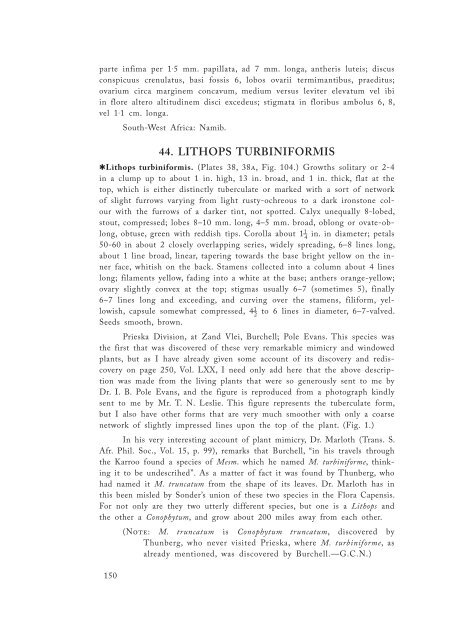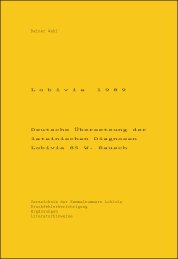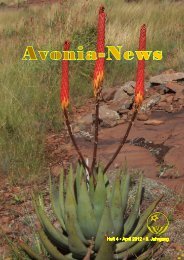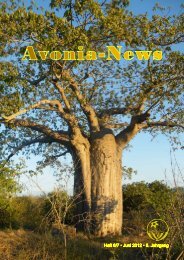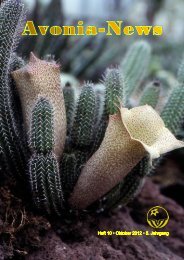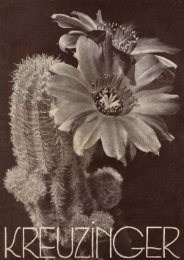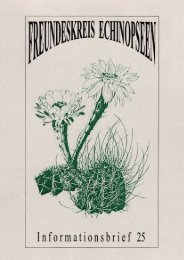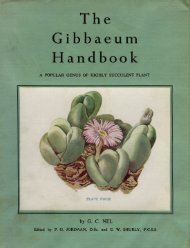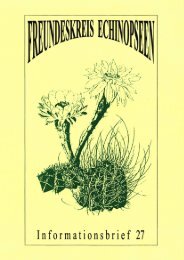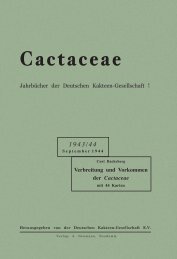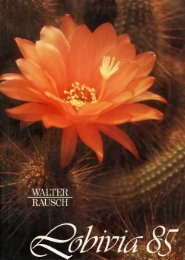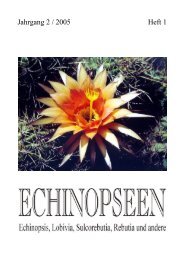Lithops - Au Cactus Francophone
Lithops - Au Cactus Francophone
Lithops - Au Cactus Francophone
You also want an ePaper? Increase the reach of your titles
YUMPU automatically turns print PDFs into web optimized ePapers that Google loves.
parte infima per 1.5 mm. papillata, ad 7 mm. longa, antheris luteis; discus<br />
conspicuus crenu latus, basi fossis 6, lobos ovarii termimantibus, praeditus;<br />
ovarium circa marginem concavum, medium versus leviter elevatum vel ibi<br />
in flore altero altitudinem disci excedeus; stigmata in floribus ambolus 6, 8,<br />
vel 1.1 cm. longa.<br />
150<br />
South West Africa: Namib.<br />
44. LITHOPS TURBINIFORMIS<br />
✱<strong>Lithops</strong> turbiniformis. (Plates 38, 38a, Fig. 104.) Growths solitary or 2 4<br />
in a clump up to about 1 in. high, 13 in. broad, and 1 in. thick, flat at the<br />
top, which is either distinctly tuberculate or marked with a sort of network<br />
of slight furrows varying from light rusty ochreous to a dark ironstone col<br />
our with the furrows of a darker tint, not spotted. Calyx unequally 8 lobed,<br />
stout, compressed; lobes 8–10 mm. long, 4–5 mm. broad, oblong or ovate ob<br />
long, obtuse, green with reddish tips. Corolla about 1 1 – 4 in. in diameter; petals<br />
50 60 in about 2 closely overlapping series, widely spreading, 6–8 lines long,<br />
about 1 line broad, linear, tapering towards the base bright yellow on the in<br />
ner face, whitish on the back. Stamens collected into a column about 4 lines<br />
long; filaments yellow, fading into a white at the base; anthers orange yellow;<br />
ovary slightly convex at the top; stigmas usually 6–7 (sometimes 5), finally<br />
6–7 lines long and exceeding, and curving over the stamens, filiform, yel<br />
lowish, capsule somewhat compressed, 4 1 – 2 to 6 lines in diameter, 6–7 valved.<br />
Seeds smooth, brown.<br />
Prieska Division, at Zand Vlei, Burchell; Pole Evans. This species was<br />
the first that was discovered of these very remarkable mimicry and windowed<br />
plants, but as I have already given some account of its discovery and redis<br />
covery on page 250, Vol. LXX, I need only add here that the above descrip<br />
tion was made from the living plants that were so generously sent to me by<br />
Dr. I. B. Pole Evans, and the figure is reproduced from a photograph kindly<br />
sent to me by Mr. T. N. Leslie. This figure represents the tuberculate form,<br />
but I also have other forms that are very much smoother with only a coarse<br />
network of slightly impressed lines upon the top of the plant. (Fig. 1.)<br />
In his very interesting account of plant mimicry, Dr. Marloth (Trans. S.<br />
Afr. Phil. Soc., Vol. 15, p. 99), remarks that Burchell, “in his travels through<br />
the Karroo found a species of Mesm. which he named M. turbiniforme, think<br />
ing it to be undescrihed”. As a matter of fact it was found by Thunberg, who<br />
had named it M. truncatum from the shape of its leaves. Dr. Marloth has in<br />
this been misled by Sonder’s union of these two species in the Flora Capensis.<br />
For not only are they two utterly different species, but one is a <strong>Lithops</strong> and<br />
the other a Conophytum, and grow about 200 miles away from each other.<br />
(Note: M. truncatum is Conophytum truncatum, discovered by<br />
Thunberg, who never visited Prieska, where M. turbiniforme, as<br />
already mentioned, was discovered by Burchell.—G.C.N.)


